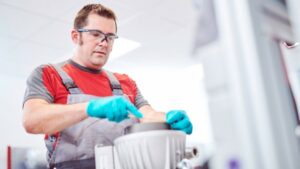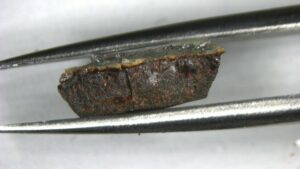Lia Merminga has just become the seventh director of the Fermi National Accelerator Laboratory in the US. She talks to Laura Hiscott about accelerator science, the future of particle physics and being the first woman to lead this iconic and influential research centre
Lia Merminga has just taken up a major mantle in the scientific world. In April, the renowned accelerator physicist took over as director of the Fermi National Accelerator Laboratory (Fermilab) – one of the most iconic particle-physics research centres in the world. Reaching that top job is a monumental achievement, and Merminga reflects on the path that led her to becoming the head of the institute where her journey in accelerator physics first began.
Growing up in her home country of Greece, where she was born in 1960, Merminga had a childhood resolve to pursue science. Indeed, one of her earliest inspirations was hearing her family tell stories about her uncle, George Dousmanis, who had a PhD in physics from Columbia University. “He was legendary in my family,” she recalls. “I have a fascinating photo of him as a graduate student with [Nobel-prize-winning physicists] Leon Lederman and Tsung-Dao Lee in the background.” Merminga’s interest in science was further galvanized by a biography of Marie Curie, which she read at the age of 13, and an excellent female physics teacher she had in secondary school. “I felt that this was a life worth living,” she says, “devoting oneself to science with such a singular purpose, advancing knowledge and having a huge impact on society”.
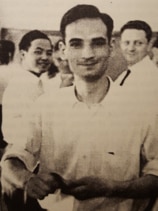
After finishing school, Merminga went on to study physics at the University of Athens. In her third year, her thesis supervisor was a professor of theoretical particle physics, and Merminga decided that this was the branch of science she wanted to go into. “It doesn’t get more profound than that,” she explains, “just understanding the most fundamental constituents and interactions of matter.”
She set her sights on postgraduate studies at the University of Michigan Ann Arbor, US, with the intention to study theoretical particle physics. Merminga’s application was successful, and in 1983 she moved across the world to follow her academic dreams.
Merminga took courses and did some research projects in her chosen discipline. But she ultimately found that theoretical particle physics wasn’t as gratifying as she had imagined, due to the long timescales between developing a theory and being able to test it experimentally. After learning about a graduate student programme in accelerator science at Fermilab, she visited the research institute for the first time. This turned out to be a pivotal moment in her career.
Accelerating science
Particle accelerators propel beams of charged particles – from protons and electrons to ions – at very high speeds, close to that of light. Accelerator science focuses on designing, operating and optimizing these huge machines to enable particle physics and many other scientific fields. Researchers constantly work on improving our ability to control and direct beams, rather than simply looking at the outcome of collisions.
“The timescales for these experiments are much shorter than in particle physics,” Merminga explains. “That appealed to me. I could develop theories and test them and get more immediate results.” So she joined the PhD programme at Fermilab, working on the Tevatron – the world’s highest-energy collider at the time.
To optimize collisions, it’s important to be able to predict and control the beam of particles in the collider tunnel, especially in the presence of not-well-studied nonlinear effects. For her PhD project, Merminga used theoretical formalisms and experimental data from the Tevatron to study how the beam dynamics reacted to the magnetic system used to steer and focus it, especially where nonlinearity became a key limiting factor to performance. Her work informed the design of the Superconducting Super Collider, which was being planned at the time.
After completing her PhD – becoming only the second student to graduate from that specific programme at the time – Merminga went to work at the Stanford Linear Accelerator Center (SLAC). Since then, she has spent a career becoming an expert in multiple areas of accelerator science. Indeed, she has held several leadership roles, including chief of the accelerator division at TRIUMF, Canada’s particle accelerator centre.
Project priorities
While Merminga was progressing in her career, Fermilab was also changing. In 2011, after almost 30 years of colliding protons and antiprotons, the Tevatron was shut down. This marked a significant shift in the lab’s focus away from high-energy experiments. Part of the rationale behind this change came from the international nature of particle physics – since no single country has the capacity to do all the experiments, it makes sense for the large research facilities to investigate different areas.
By 2011, CERN’s Large Hadron Collider was up and running at higher energies than the Tevatron; so Fermilab saw the opportunity to take the lead in high-intensity experiments instead. The latter are particularly important for studying neutrinos; these tiny particles have extremely low rates of interaction, so to observe any such events it is essential to generate huge quantities of them.
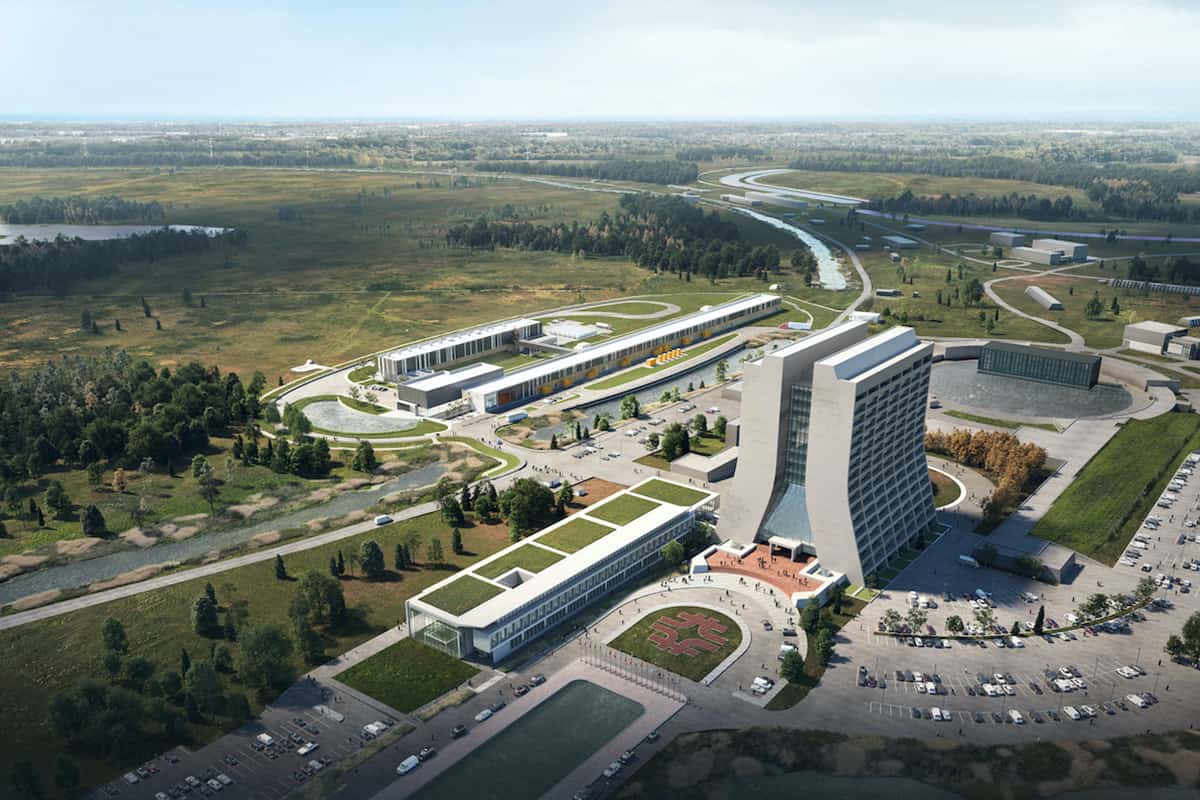
In 2015, to support new experiments, Fermilab started building the Proton Improvement Plan-II (PIP-II), and Merminga returned to her alma mater to lead the project. PIP-II is a 215 m-long linear accelerator that will serve as the heart of Fermilab’s new accelerator complex and contribute to multiple new experiments. One of PIP-II’s main goals is to create the most intense beam of neutrinos in the world, by launching its intense proton beam into a graphite target. These neutrinos will be sent through the two Deep Underground Neutrino Experiment (DUNE) detectors, which are currently under construction – one at Fermilab and the other 1300 km away in South Dakota.
The reason for being located so far away is that neutrinos come in three “flavours” – electron, muon and tau – and they exhibit the strange behaviour of “oscillating” between these types as they travel. The large distance between the two detectors increases their sensitivity to these oscillations, with this behaviour potentially having profound implications for the whole universe. Physicists think there might be a difference in the way that neutrinos and antineutrinos oscillate between their flavours, which would indicate a violation of matter–antimatter symmetry (C–P violation) and physics beyond the Standard Model. Such a difference might even be the key to why there is more matter than antimatter in the universe – a crucial condition for our own existence.
I’d love to see DUNE reach the definitive answer to neutrino oscillations and C–P violation as fast as possible because it’s related to matter–antimatter asymmetry, and why we are even here at all
Lia Merminga
So Merminga hopes that the neutrino studies powered by PIP-II will shed light on this big question. “I’d love to see DUNE reach the definitive answer to neutrino oscillations and C–P violation as fast as possible,” she says, “because it’s related to matter–antimatter asymmetry, and why we are even here at all.”
Merminga is also excited by the associated technology, such as superconducting radio-frequency (SRF) technology – in which Fermilab is a world leader – and she is keen to see how far the institute can push the limits there. SRF improves accelerator performance by avoiding the energy loss that normally occurs through resistance to currents in the accelerator walls. PIP-II’s structures will be made of superconducting niobium and cooled to 2 K to take advantage of this property.
Now that she is director of Fermilab as a whole, rather than of PIP-II specifically, Merminga won’t be quite as closely involved in it as she was before, but she intends to keep up with its progress and remains passionate about the project. “When it’s finished it’s going to be used for another 50 years by generations that come after me,” she says. “It’s powerful to contribute to something of lasting value.”
Trailblazer
While scientific knowledge has been progressing, so too has the world around it. Perhaps the fact that Fermilab is being led by a woman for the first time is a testament to those changes. Personally, Merminga does not feel her gender has been an obstacle in her career, and she emphasizes the power of technical proficiency.
“When I’m the only woman in a room,” she explains, “if I give the right answers or have the right insights, they’re going to stop thinking of me as a woman and focus on what I contribute. That’s how I’ve dealt with this in my career. Be very good at what you do and they’ll have to listen to you sooner or later.” Nevertheless, she believes that the under-representation of women in physics needs to change, adding that teams are much more impactful and effective when they have more diverse perspectives to draw on.
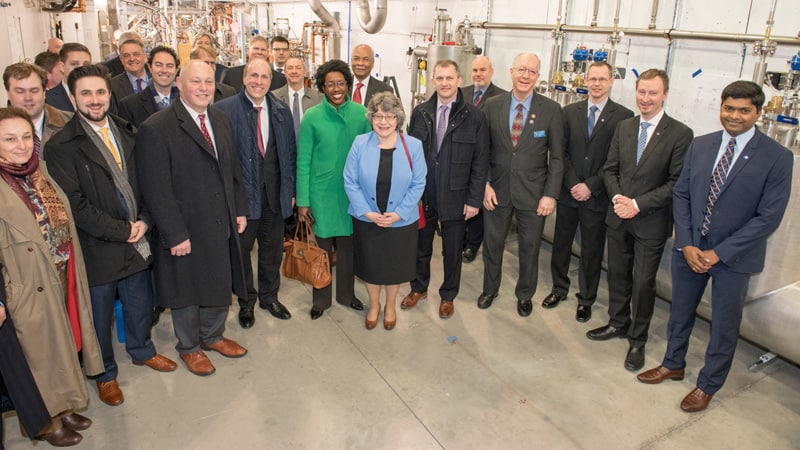
Merminga attributes much of her confidence to having attended an all-girls school, noting that boys can sometimes be more assertive. “Until I was 18, I was in an environment that was a little bit protected,” she says. “That helped me build confidence in myself. When I went to university, only 10% of students were women, but by then I had built enough confidence that it didn’t matter.”
Merminga therefore believes that girls-only physics programmes could help girls to feel more empowered to study the subject. But she says we need a multi-pronged solution that also addresses the practical issues people face throughout their careers. Fermilab, for example, has on-site day-care that enables parents to focus on their jobs more easily.
Another major factor is of course increasing the visibility of women in the subject. Merminga notes that this was helpful for her, having been inspired by her female physics teacher when she was in school, and then later by Helen Edwards, the lead physicist in the construction of the Tevatron. “To see someone in action is very powerful,” she says.
Fortunately, this has improved further in recent years. Since 2016, the experimental particle physicist Fabiola Gianotti has been director-general of CERN, also the first woman to hold that position. With Merminga taking the helm at Fermilab, two of the highest-profile jobs in physics are now occupied by women. So although there is still work to be done, this feels like a significant milestone.
Formulating the future
Although Merminga has led major projects and programmes before, directing such a large institute as Fermilab is a new challenge for her, as the bigger scale means added complexity. But she believes that the fundamental principles of leadership and managing a large scientific entity remain the same.
“It’s important to have a clear vision,” she says, “and to be able to articulate it to every employee; to have a plan to realize that vision; and to hold myself and everyone else accountable to deliver on it.”

Preparing for a post-LHC future
So what is Merminga’s vision for Fermilab? This is something that she is still formulating, having only just taken over, and she is keen to consider lots of perspectives. One of the first actions she took in April was to embark on a “listening tour”, to hear from lab employees and Fermilab’s user community. While the specifics are still in the works, she describes the broad strokes of her ambition for Fermilab is for it to “lead the world in particle physics and accelerator science, technology and innovation, underpinned by a diverse and world-class workforce; by excellent and robust operations and business systems; by a sustainable campus strategy integrated with our mission; and by enduring and enabling partnerships, regional, national and international.”
Reflecting on her career, she says she has many feelings about becoming director of the institute where she first started out in accelerator science. “I’ll sum it up in two words: profound gratitude,” she says. “I was very privileged to be here as a grad student, doing experiments with some of the world’s best physicists and with the most advanced collider that existed at the time. How lucky can one get? The poem ‘Ithaca’ by Greek poet Constantine Cavafy comes to mind. He writes ‘Ithaca gave you the marvellous journey.’” Perhaps this inspires a more personal side of her mission as director, as she emphasizes that she now wants to give other young scientists similar opportunities. And as well as paying it forward, she wants to honour the legacy of previous generations of physicists and the former directors of Fermilab.
I feel responsibility and gratitude, and a lot of optimism that we can continue this trajectory
Lia Merminga
Looking back, it seems serendipitous that one of those former directors, Leon Lederman, is in the background of the photo picturing Merminga’s uncle. “We stand on the shoulders of giants,” she says. “I feel this big responsibility to continue the tradition of Fermilab being this great institution recognized around the world for innovation and breakthrough discoveries. I feel responsibility and gratitude, and a lot of optimism that we can continue this trajectory.”


